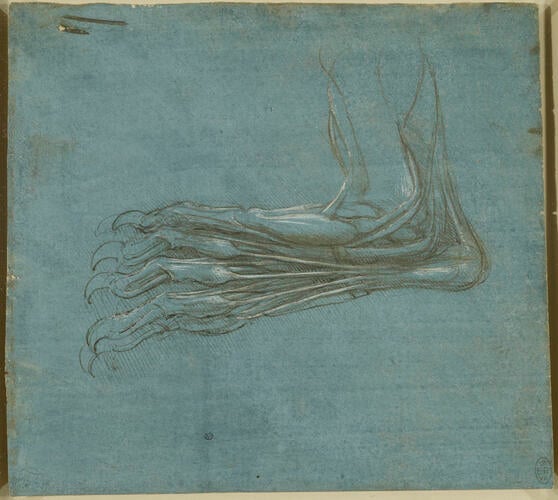-
1 of 253523 objects
A bear's foot c.1488-90
Metalpoint with pen and ink and white heightening, on blue-grey prepared paper | 15.5 x 17.3 cm (sheet of paper) | RCIN 912375
-
During the latter part of the 1480s, Leonardo dissected the left hind leg of a bear. At that time bears were common in the mountains of Italy; they were hunted for sport and kept in captivity for entertainment, and Leonardo could thus easily have obtained a specimen for dissection. His particular interest in the animal was probably due to its plantigrade gait – like humans, bears walk with their feet flat on the ground (digitigrade animals such as dogs and cats walk on some portion of the digits, and unguligrade animals such as horses or cattle walk on the tip of a digit, usually in the form of a hoof). Leonardo’s dissection would therefore have given him an insight into the anatomy of the human foot at a time when he had little access to human material.
The drawing shows the bones, muscles and tendons of the lower leg and foot of a bear, in a lateral or outside view of the foot, partially from below. The tendons of fibularis longus, brevis and tertius pass behind the lateral malleolus (ankle bone). The Achilles or calcaneal tendon is shown inserting on the calcaneus. The multiple tendons of flexor digitorum brevis are prominent, forming broad expansions at the sites of their insertion, and the tendons of flexor digitorum longus are visible beneath them. The relationship of the brevis and longus tendons is studied in more detail in the fragment pasted on to RCIN 912373.
Text adapted from M. Clayton and R. Philo, Leonardo da Vinci: Anatomist, London 2012, no. 9Provenance
Bequeathed to Francesco Melzi; from whose heirs purchased by Pompeo Leoni, c.1582-90; Thomas Howard, 14th Earl of Arundel, by 1630; Probably acquired by Charles II; Royal Collection by 1690
-
Creator(s)
Acquirer(s)
-
Medium and techniques
Metalpoint with pen and ink and white heightening, on blue-grey prepared paper
Measurements
15.5 x 17.3 cm (sheet of paper)
Other number(s)
